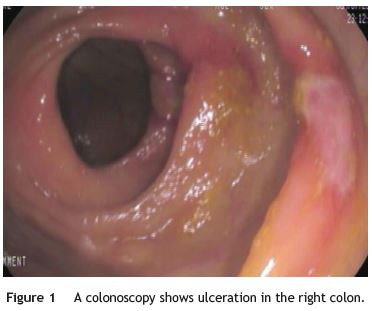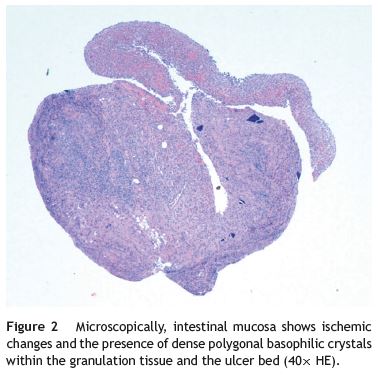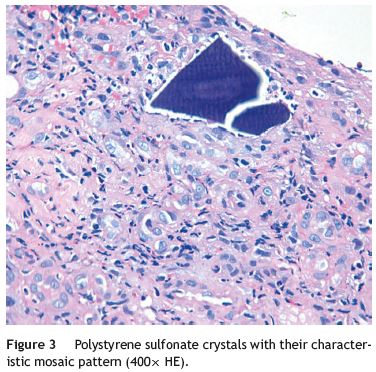Serviços Personalizados
Journal
Artigo
Indicadores
-
 Citado por SciELO
Citado por SciELO -
 Acessos
Acessos
Links relacionados
-
 Similares em
SciELO
Similares em
SciELO
Compartilhar
GE-Portuguese Journal of Gastroenterology
versão impressa ISSN 2341-4545
GE Port J Gastroenterol vol.22 no.3 Lisboa jun. 2015
https://doi.org/10.1016/j.jpge.2015.02.003
IMAGES IN GASTROENTEROLOGY AND HEPATOLOGY
Hematochezia in a Patient with Renal Failure and Hyperkalemia
Hematoquésia num Doente com Insufiência Renal e Hipercaliémia
Tânia Meiraa,∗, Vitor Fernandesa, Helder Coelhob
a Gastroenterology Department, Hospital Garcia de Orta, Almada, Portugal
b Pathology Department, Hospital Garcia de Orta, Almada, Portugal
* Corresponding author.
A 68-year-old man with history of hypertension, type 2 diabetes mellitus, coronary artery disease, aortic stenosis and chronic kidney disease. Relevant medications included bisoprolol, furosemide, atorvastatin, perindopril/amlodipine, metformin/sitagliptin and aspirin. The patient was admitted in the emergency department for acute decompensated heart failure and acute-on-chronic renal failure with hyperkalemia. He began treatment with cation exchange resin (40 g/day), which was continued for 3 days. On the fourth day of hospitalization, the patient presented hematochezia with hemodynamic repercussion and anemia (hemoglobin, 7.5 g/dl). Two units of packed red blood cells have been transfused and an endoscopic examination was requested, the colonoscopy revealed three ulcers with about 10mm, congested and edematous surrounding mucosa, in the proximal ascending colon (Fig. 1). Histological evaluation of the ulcer biopsies identified several rhomboid crystals of sodium polystyrene sulfonate. This clinical case was assumed to be a sodium polystyrene sulfonate-induced colitis (Figs. 2 and 3). The patient was discharged without evidence of rebleeding.



Sodium polystyrene sulfonate (SPS) is a drug used in the treatment of hyperkalemia. Its action begins in the stomach, with the exchange of sodium ions for hydrogen ions that, along the digestive tract, are exchanged for potassium ions, which are, in turn, eliminated in the feces, consequently reducing the levels of serum potassium. SPS can cause constipation and fecal impaction, and is often administrated combined with sorbitol or other hypertonic laxative. The mechanism of injury to the mucosa of the gastrointestinal tract is not yet clear: It is believed that the sorbitol additive, due to its cathartic effect, induces changes in the intestinal microcirculation vasculature and that its osmotic action results in/contributes to direct mucosal injury.1 In our case, sorbitol or other laxative was not concomitantly administered, likewise in a previous case report described by Tapaya et al.2 Such fact suggests that the adverse effect is not correlated with the use of laxatives, but SPS may have a significant role inducing digestive tract lesions. Colitis due to SPS occurs in 1% of the cases, especially in postsurgical patients and patients with advanced renal disease, the last condition as was the case of our patient.3,4 Clinical presentation varies, ranging from abdominal pain, nausea, diarrhea and hematochezia. Endoscopic findings are nonspecific: mucosal edema, ulcers, pseudomembranes and, in more severe cases, necrosis and intestinal perforation.4 Descriptions of previous cases indicate that symptoms can appear up to 11 days after the drugs administration, in our patient, the symptoms appeared 3 days after taking SPS, suggesting its early adverse effect. Several differential diagnoses, such as inflammatory bowel disease, infection and ischemia should be considered; therefore, the histological analysis of the biopsies is essential for definitive diagnosis. Microscopically, the biopsy specimens showed polygonal crystals, basophilic and nonpolaring, with mosaic pattern.5 Patient management includes supportive care, avoiding drugs and, in the most severe cases, intestinal resection may be required.
References
1. Chou YH, Wang HY, Hsieh MS. Colonic necrosis in a young patient receiving oral kayexalate in sorbitol: case report and literature review. Kaohsiung J Med Sci. 2011;27:155-8. [ Links ]
2. Tapaia C, Schneider T, Manz M. From hyperkaliemia to ischemic colitis: a resinous way. Clin Gastroenterol Hepatol. 2009;7:e46-7. [ Links ]
3. Rashid A, Hamilton SR. Necrosis of the gastrointestinal tract in uremic patients as a result of sodium polystyrene sulfonate (kayexalate) in sorbitol: an underrecognized condition. Am J Surg Pathol. 1997;21:60-9. [ Links ]
4. Abrham SC, Bhagavan BS, Lee LA, Rashid A, Wu TT. Upper gastrointestinal tract injury in patients receiving kayexalate in sorbitol. Am J Surg Pathol. 2001;25:637-44. [ Links ]
5. Mc Gowan CE, Saha S, Chu G, Resnick MB, Moss SF. Intestinal necrosis due to sodium polysterene sulfonate in sorbitol. South Med J. 2009;102:493-7. [ Links ]
* Corresponding author.
E-mail address: tania_meira@hotmail.com (T. Meira).
Ethical disclosures
Protection of human and animal subjects. The authors declare that no experiments were performed on humans or animals for this study.
Confidentiality of data. The authors declare that no patient data appear in this article.
Right to privacy and informed consent. The authors have obtained the written informed consent of the patients or subjects mentioned in the article. The corresponding author is in possession of this document.
Conflicts of interest
The authors have no conflicts of interests to declare.
Received 8 January 2015; accepted 18 February 2015














